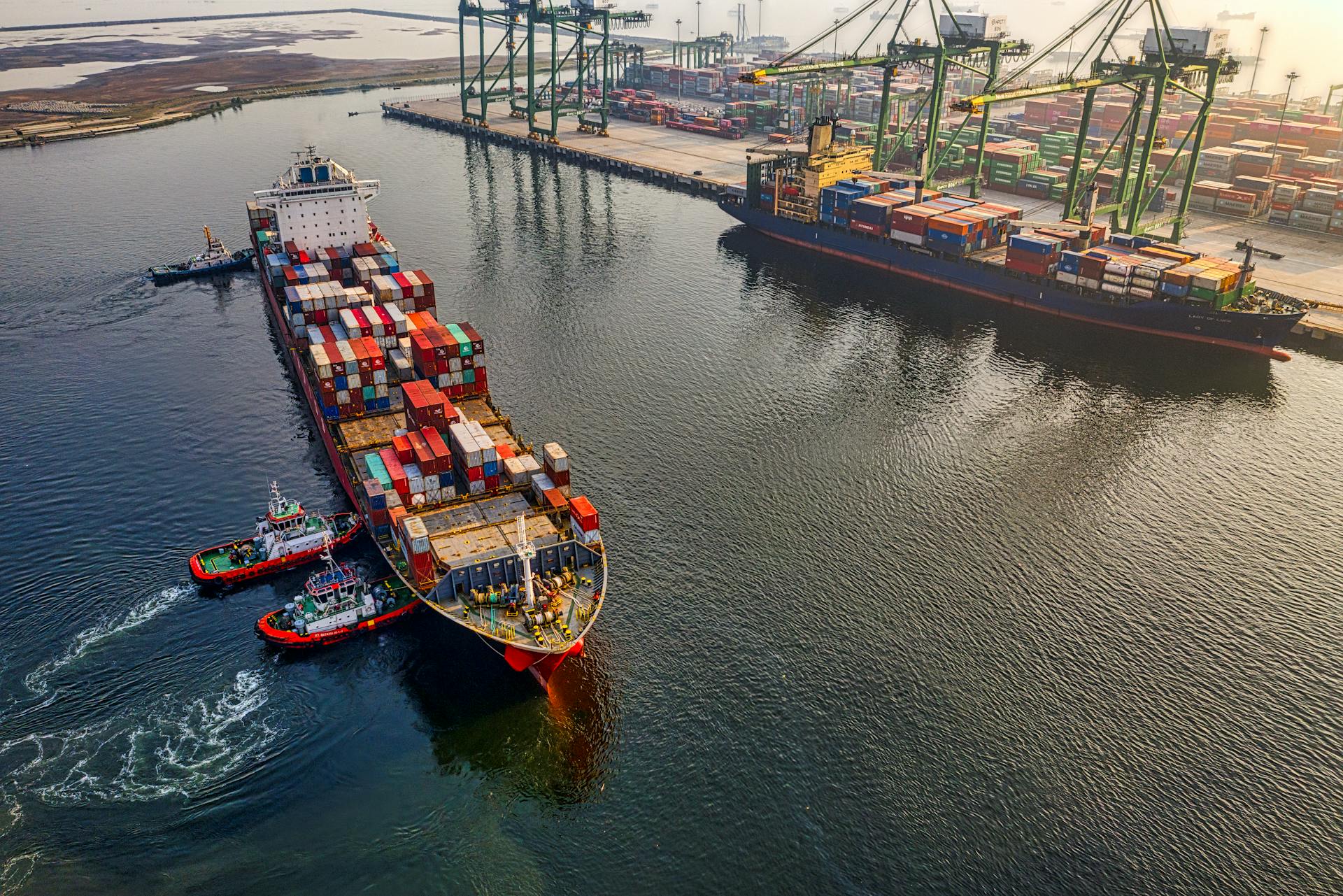
The RV Roger Revelle is a state-of-the-art research vessel designed for a variety of oceanographic and atmospheric studies. It's equipped with a range of advanced instruments and sensors.
The ship has a length of 274 feet and a beam of 62 feet, making it well-suited for navigating open ocean waters. Its gross tonnage is 3,800 tons.
The RV Roger Revelle is powered by two diesel engines, each producing 1,500 horsepower, giving it a top speed of 14 knots.
Check this out: MV Roger Blough
Scientific Capabilities
The R/V Roger Revelle is a highly capable oceanographic research vessel that's been extensively upgraded to meet the needs of scientists.
It was constructed in 1996 and has undergone a major refit in 2020, which included a complete repower and new controls, significantly improving its scientific capabilities.
The vessel is equipped with an under-hull acoustics gondola that houses most of its acoustics sensors, including deep- and shallow-water multibeam mapping systems.
These sensors provide the capability to map the ocean floor in great detail, which is crucial for understanding ocean currents and marine ecosystems.
The gondola also hosts a multi-frequency midwater imaging system, a sub-bottom profiler, and several acoustic Doppler current profilers operating at different frequencies.
These instruments allow scientists to study the ocean's currents, temperature, and salinity in unprecedented detail.
The vessel's suite of shared-use instrumentation is carefully maintained and regularly upgraded to offer scientists the most capable sensors available.
This includes a one-of-a-kind dual-frequency (50-140 kHz) Doppler sonar that measures current shear at high resolution.
The R/V Roger Revelle is operated by Scripps Institution of Oceanography under a charter agreement with the Office of Naval Research.
The vessel is one of six major oceanographic research vessels owned by the U.S. Navy and operated for shared-use through the University-National Oceanographic Laboratory System.
The National Science Foundation is the primary U.S federal agency supporting research at the frontiers of knowledge, and they provide important support for research vessel operations at Scripps Institution of Oceanography.
Discover more: Russian Research Vessel Yantar
Vessel Details
The RV Roger Revelle is a research vessel that's perfect for studying the ocean and its effects on the environment. It's a state-of-the-art ship that's equipped with the latest technology.
The vessel is 274 feet long and has a beam of 58 feet. It's a large ship, but it's designed to be efficient and maneuverable in the water.
The RV Roger Revelle is powered by a diesel-electric propulsion system, which provides a reliable and quiet source of power for the ship's systems.
Ship Namesake
The ship's namesake, Roger Revelle, was a renowned scientist who made significant contributions to our understanding of the greenhouse effect and carbon dioxide's impact on the atmosphere. He was a true pioneer in his field.
Roger Revelle was the former director of Scripps Institution of Oceanography and played a key role in establishing the study of the greenhouse effect. His work laid the foundation for modern sustainable development principles.
Dr. Revelle was also instrumental in founding the modern Office of Naval Research and co-founded the University of California - San Diego. His legacy continues to inspire new generations of scientists and researchers.
Here are some key facts about the ship's design and capabilities:
The ship's endurance and range are impressive, with the ability to stay at sea for up to 60 days and travel 15,000 nautical miles.
Ship Repair and Maintenance

Ship repair and maintenance is a crucial aspect of keeping vessels seaworthy and compliant with regulations. The R/V Roger Revelle's mid-life refit is a prime example of this, with a comprehensive overhaul package that included a repower and replacement of aging shipboard equipment.
The Revelle's overhaul package was designed by Glosten, who provided a design basis, general specifications, and stability evaluation to ensure a safe and successful refit. Glosten's expertise was instrumental in meeting the client's needs and regulatory requirements.
A key aspect of the Revelle's refit was the replacement of technically obsolete shipboard machinery, which was a major priority for the vessel's operators. This upgrade will help to improve the vessel's performance and reduce maintenance costs in the long run.
The Revelle's refit was completed at Vigor's Portland shipyard in 2020, and the vessel is now one of the largest and most advanced in the US Academic Research Fleet.
Equipment and Gear
The RV Roger Revelle is equipped with a range of support equipment to facilitate its research and mission. The ship has three primary cranes on board, located on the starboard quarter, main deck, and port side at the 02 level.
These cranes are joined by two Morgan Marine cranes, which can be positioned on the foredeck and other locations as needed. Additionally, the ship has a Fritz-Culver A-frame at the stern and a retractable hydroboom on the starboard side by the staging bay door.
The RV Roger Revelle also features a Blue Extension crane on the starboard 01 level, aft of the rescue boat davit. Furthermore, the ship has extensive bolt-down fittings for securing removable equipment on all decks and inside laboratories, with a 2' x 2' pattern.
See what others are reading: MV Shōnan Maru 2
Research Equipment
The Revelle's research equipment has been upgraded to enhance its mission capabilities.
The ship now features four new generators and an integrated bus, replacing its previous six generators. This upgrade has significantly reduced noise and vibration, allowing for better science.

A retractable ZF bow thruster has been installed, which reduces related noise and vibration even further. This improvement enables more accurate data collection from the sonars.
The ship's cranes and overboard handling systems have also been upgraded, making it easier to conduct research at sea. A gondola containing scientific transducers has been added, positioning the transducers below the hull to mitigate interference from bubbles.
The Revelle is equipped with a range of winches, including the Markey DUTW-9-11 traction-drum winch and the Markey DESH 5 hydrographic winch. These winches can handle up to 15,000 meters of trawl wire and 10,000 meters of hydrographic wire, respectively.
Here are some of the Revelle's winches and their specifications:
- Markey DUTW-9-11 traction-drum winch: 15,000 m of 9/16" 3 x 19 trawl wire, 10,000 m of 0.680" electromechanical cable
- Markey DESH 5 hydrographic winch: 10,000 m of 1/4" 3 x 19 hydrographic wire, 10,000 m of 0.322" three-conductor electromechanical CTD cable
- CAST-6/Allied Crane CTD Handling System: 10,000 m of 0.322" three-conductor electromechanical CTD cable
Support Equipment
The support equipment on this vessel is quite impressive, with a variety of cranes and lifting gear scattered across the deck.
Primary cranes are located on the starboard quarter, main deck, and port side at the 02 level. These cranes are North American cranes, and there are three of them in total.
Morgan Marine cranes are also available, and they can be found on the foredeck or at other locations as needed. This flexibility is likely a result of the vessel's mission requirements.
A Fritz-Culver A-frame is located at the stern, and a retractable hydroboom is situated on the starboard side by the staging bay door.
You'll also find a Blue Extension crane on the starboard 01, located aft of the rescue boat davit.
The vessel has extensive bolt-down fittings for securing removable equipment, with over 3,000 fittings scattered across all decks and inside the laboratories. These fittings are spaced 2 feet by 2 feet apart, with 1-inch sockets on the outside and 1/2-inch sockets on the inside.
The laboratories have an uncontaminated seawater supply, which is essential for sensitive equipment. However, the computer lab is an exception to this rule.
Two Price A300 compressors provide 1850 psi air for seismic work, which is a critical function for the vessel's mission.
Featured Images: pexels.com

